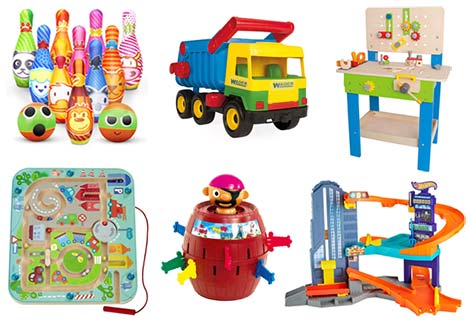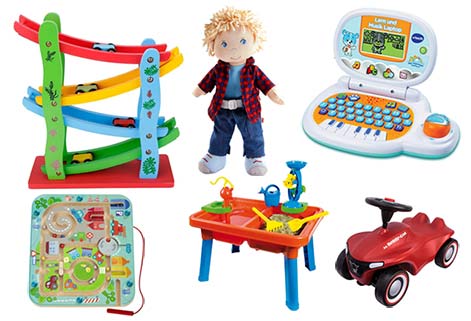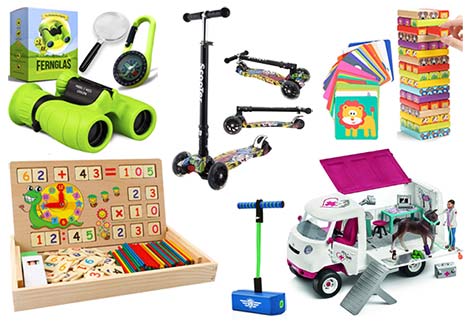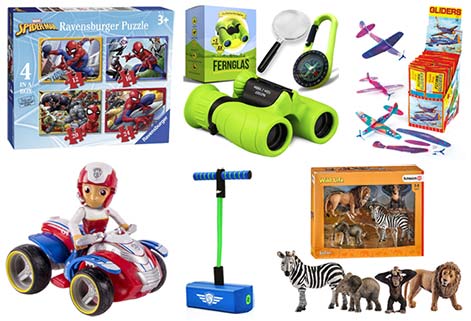Geschenke für 4-jährige Jungs
Welches Spielzeug ist bei 4-jährigen Jungs angesagt? Was kann man dem Nachwuchs zum Geburtstag, zu Ostern und zu Weihnachten schenken? Auf dieser Seite findest du sinnvolle Geschenke für Jungen im Alter von 4 Jahren. Wir haben Geburtstagsgeschenke, Weihnachtsgeschenke und Ostergeschenke gesammelt, an denen Vierjährige noch lange Spaß haben.
Die schönsten Spielsachen und Geschenkideen für Jungen ab 4 Jahren
Das vierte Lebensjahr ist für Jungs und ihre Eltern ein aufregendes Alter. Die Kinder verstehen Spielregeln, ihre sprachlichen Fähigkeiten entwickeln sich rasant weiter und ein erstes Zahlenverständnis ist bereits vorhanden. Unter den Weihnachtsgeschenken für 4-jährige Kinder dürfen sich jetzt auch gerne einfache Brettspiele, Lernbücher oder Musikinstrumente befinden. Zudem kann man Jungen im Alter von 4 Jahren Spielsachen schenken, die sie aus Einzelteilen zusammenbauen müssen. Je nach Entwicklungsstand der Kleinen können die Anforderungen beim Zusammenbau höher oder niedriger sein. Bausteinsysteme von Lego oder Holzspielzeug von Eichhorn wird beim Nachwuchs immer beliebter. Ein wenig Hilfestellung von Erwachsenen ist hier und da beim Zusammenbau von Fahrzeugen, Flugzeugen, Raumschiffen oder Ritterburgen noch notwendig, aber schon bald sind 4-jährige Jungen so geschickt beim Zusammensetzten, dass die Objekte immer größer werden und aus immer mehr Einzelteilen bestehen. In dieser Entwicklungsphase sind Lernspielsachen ideale Geburtstagsgeschenke, Ostergeschenke und Weihnachtsgeschenke, weil die Kleinen viel erforschen und verstehen möchten.
Checkliste: Spielsachen und Geschenke für Jungen im Alter von 4 Jahren
- Jungen haben mit 4 Jahren ein zunehmendes Interesse an gemeinsamen Spielen. Gesellschaftsspiele wie Brett- oder Kartenspiele gewinnen zunehmend an Bedeutung.
- Der vierjährige Nachwuchs kann bereits viele Wörter aussprechen und verstehen. Der Wortschatz kann mit Vorlesen von Gute-Nacht-Geschichten, dem Lernen von Wörtern anhand von Bildern sowie mit spannenden Hörspielen weiter ausgebaut werden.
- Mit 4 Jahren ist bei den Kindern bereits ein Zahlenverständnis vorhanden, dass sich mit einfachen Zähl- und Zahlenspielen weiter verbessern lässt.
- Bei 4-Jährigen Jungs ist das Musik- und Rhythmusgefühl bereits so weit ausgeprägt, dass man die Entwicklung mit Musikinstrumenten weiter fördern kann.
- Die Feinmotorik der Kinder bildet sich in dem Alter immer mehr aus und kann mit Geschicklichkeitsspielen unterstützt werden.
Themenwelten und erweiterbares Spielzeug – Ab 4 Jahren wünschen sich viele Jungs ein Geschenk von Lego oder Playmobil
Ab dem 4. Lebensjahr werden Spiele-Klassiker wie Lego und Playmobil immer interessanter für Jungs, deren Spiel ab diesem Alter schon sehr kreativ und phantasievoll ist. Ganz gleich, ob vierjährige Jungen Piraten, Bauarbeiter oder Ritter mögen – Mit beiden Marken können die Kinder ganze Themenwelten aufbauen und mit weiteren Spielfiguren, Fahrzeugen oder Flugobjekten sinnvoll erweitern. Für jeden Geldbeutel ist etwas dabei und auch über kleine Geschenke wie etwa eine Playmobil-Schatzkiste mit Goldmünzen oder weitere Tiere für den Bauernhof freuen sich die Vierjährigen. Das beliebig erweiterbare Spielzeug hat soviel zu bieten, dass den Erwachsenen die Geschenkideen nicht so schnell ausgehen. Oft sind es schon die Kinder, die sich bereits passendes Spielzeug zu ihrem Lego- oder Playmobil-Inventar von den Eltern, Tanten oder den Großeltern wünschen. Doch aufgepasst: Ist das Kind ein Piraten-Fan, sollte das Playmobil-Geschenk zu diesem Thema passen. Etwas kniffeliger wird es bei Lego, das richtige Geschenk für einen vierjährigen Jungen zu finden. Bei der beliebten Marke für zusammensetzbare Bausteine sind Fahrzeuge, Schiffe, Flugobjekte oder Ritterburgen stark angesagt, die die Kleinen erst einmal aus vielen Einzelteile zusammenbauen müssen. Die Wünsche von heranwachsenden Jungs sind bei einer riesigen Lego-Auswahl so speziell, dass Erwachsene sich besser vorher mit den Kindern absprechen, bevor sie ein entsprechendes Geschenk kaufen.
4-jährige Jungs zum Spielen von Kartenspielen, Brettspielen und Memorys animieren
Zum Geburtstag und zu Weihnachten stehen auf der Wunschliste von 4-Jährigen oft populäre Spielfiguren aus Film und Fernsehen oder ein Geschenk von Lego oder Playmobil. Weitaus weniger wünschen sich Jungs in diesem Alter Brettspiele, Memorys oder Kartenspiele. Umso wichtiger ist es für Eltern, ihre Söhne für Gesellschaftsspiele zu begeistern. Beim gemeinsamen Spielen lernen die Kinder den Spielablauf und die Regeln, die sie einhalten müssen. Das Kennenlernen von Zahlen und Begrifflichkeiten sowie die Zuordnung von Farben, Formen, Tieren oder Verkehrsmitteln schult die geistigen Fähigkeiten wie Zählen, Kombinieren und Assoziieren. Deshalb ist es sinnvoll, eine Spielesammlung mit pädagogisch wertvollen Spielen aufzubauen. So können Eltern immer wieder gemeinsam mit ihren Kindern spielen und so mehr Zeit mit ihnen verbringen.
Was kann man einem 4-jährigen Jungen schenken?
1. Montessori Lernspielzeug
Schon im Vorschulalter sollten Eltern darauf bedacht sein, dass ihr 4-jähriger Sohn beim Spielen mit Zahlen und Buchstaben in Berührung kommt. Kinder, die bei der Einschulung bereits ein erstes Zahlenverständnis aufweisen, finden einen schnellen Zugang zur Mathematik in der Grundschule und darüber hinaus. Montessori Spielzeug wie Zahlen-Puzzles oder Mathe-Lernkästen helfen beim Kennenlernen der Zahlen von Eins bis Hundert und eigenen sich zur Veranschaulichung der ersten Rechenaufgaben.
2. Geschicklichkeitsspiele
Wackelturm, Angelspiel und andere Geschicklichkeitsspiele motivieren 4-jährige Jungs im besonderen Maße, weil sie ihre motorischen Fähigkeiten in Konkurrenz zu anderen Spielern unter Beweise stellen müssen. Viel Spaß und Action steht dabei zumeist an erster Stelle, was bei Jungen immer für große Begeisterung beim Spielen sorgt. Kinder in diesem Alter zeigen gerne, was sie schon alles können und gelernt haben. Um die motorische Entwicklung der Kleinen zu fördern, ist ein Geschicklichkeitsspiel das passende Geburtstagsgeschenk.
3. Erste Spielesammlung
Ab dem 4. Lebensjahr ist es sinnvoll, Kindern eine Spielesammlung zu schenken. Bei „Mensch ärgere dich nicht“, „Mühle“ und „Dame“ lernen kleine Jungs, sich an Spielregeln zu halten und Rücksicht auf Mitspieler zu nehmen. Die kurzweiligen Gesellschaftsspiele bieten Eltern die Möglichkeit, mehr Zeit mit ihrem Nachwuchs zu verbringen und mehr über ihre Kinder zu erfahren.
4. Outdoor-Spielzeug
Kinder zum Spielen im Freien zu animieren, ist oft nur eine Frage der Motivation. Das richtige Outdoor-Spielzeug ist in dieser Hinsicht gerade bei vierjährigen Jungs wichtig. Um die Kleinen vom Fernseher und anderen Unterhaltungsmedien wegzulocken, ist vor allem Outdoor-Spielzeug mit viel Action gefragt. Ballspiele, ferngesteuerte Autos, Kinderroller oder Wasserpistolen vermögen Vierjährige nach draußen zu locken und viel Zeit an der frischen Luft zu verbringen. Spielsachen, mit dem Gruppen- und Mannschaftsspiele möglich sind, integrieren die Freunde in das Spiel und fördern das soziale Miteinander der Kinder.
Spielsachen für 4-jährige Jungs: Achte auf die Qualität der Geschenke
Toben, klettern, matschen, experimentieren – Vierjährige Jungs wollen die Welt entdecken und Zusammenhänge verstehen. In diesem Alter versuchen Eltern, ihren Nachwuchs zum Aufräumen und sorgsamen Umgang mit dem Spielzeug zu erziehen. Jedoch können die Erwachsenen von ihren Sprösslingen in Sachen Ordnung und Sorgsamkeit noch nicht viel verlangen. Und so werfen die Kleinen ihre Spielsachen durch die Gegend, lassen sie fallen oder spielen damit im Matsch oder feuchten Sand. Wegen der großen Beanspruchung des Materials, eignet sich robustes Spielzeug am besten zum Verschenken, damit die Vierjährigen noch lange Spaß und Freude daran haben. Bei Spielsachen für 4-jährige Jungs gilt: Weniger ist mehr. Das heißt: Lieber die Anzahl der Geschenke reduzieren, aber dafür auf eine hohe Qualität bei stark beanspruchtem Spielzeug achten.
- Die 47 beliebtesten Spielzeuge für 4-jährige Kinder
- Kleine Geschenke für Kinder unter 5 Euro
- Kleine Geschenke für Kinder unter 10 Euro
- Geschenke für kleine Handwerker
- Geschenke für 1-jährige Jungs
- Geschenke für 2-jährige Jungs
- Geschenke für 3-jährige Jungs
- Geschenke für 5-jährige Jungs
- Geschenke für 6-jährige Jungs
- Geschenke für 1-jährige Mädchen
- Geschenke für 2-jährige Mädchen
- Geschenke für 3-jährige Mädchen
- Geschenke für 4-jährige Mädchen
- Geschenke für 5-jährige Mädchen
- Geschenke für 6-jährige Mädchen
- Geschenke für 1-jährige Kinder
- Geschenke für 2-jährige Kinder
- Geschenke für 3-jährige Kinder
- Geschenke für 4-jährige Kinder
- Geschenke für 5-jährige Kinder
- Geschenke für 6-jährige Kinder
- Die 41 beliebtesten Spielzeuge für 3-jährige Kinder
- Das beste Lernspielzeug für Kinder ab 4 Jahren
- Balkonspielzeug: 5 tolle Balkon-Spielsachen für Kinder
- Gartenspielzeug: 50 tolle Outdoor-Spielzeuge für Kinder
- Die 10 beliebtesten Spielzeugpistolen für Kinder
- Das beste Bosch Kinderwerkzeug für kleine Handwerker






